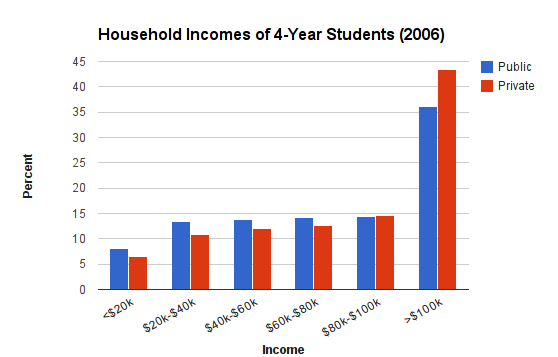The National Postsecondary Student Aid Survey has a breakdown of what types of students make up each kind of postsecondary school. I have been interested for some time in the breakdown of undergraduates by household income, and it provides those numbers (p. 72 of the pdf). There is a lot in the survey and I wont go over it all here. I will make one comparison though between the class composition of public 4-year doctoral-granting institutions and private 4-year doctoral-granting institutions. In particular, I want to know how different the income breakdown of undergraduates is at such schools.
For the purposes of this comparison, I am only looking at dependent students. So independent students are not being counted. Independent students make up 26.3 percent of students at public 4-years and 26.2 percent of students at private 4-years. Independent students at publics and privates do not appear to be that different from one another, and their reported incomes do not reflect the incomes of their families, which is why I exclude them.
With that out of the way, here is a graph that basically answers this question: what percentage of enrolled dependent students come from each income bracket?

There is a difference between the 4-year doctoral-granting public schools and 4-year doctoral-granting private schools, but not one to write home about. The distribution of private school students is tilted somewhat more towards the high-income, but only a little. Among the public schools, slightly more than half of students come from households with greater than $80k of income. Doing a little inflation adjusting and looking at some historical census numbers, this means that just over half of students at these 4-year publics have household incomes right around or over the threshold for being in the richest 1/4th of households. So public 4-year doctoral-granting institutions skew very considerably towards rich kids, although somewhat less so than their private counterparts.